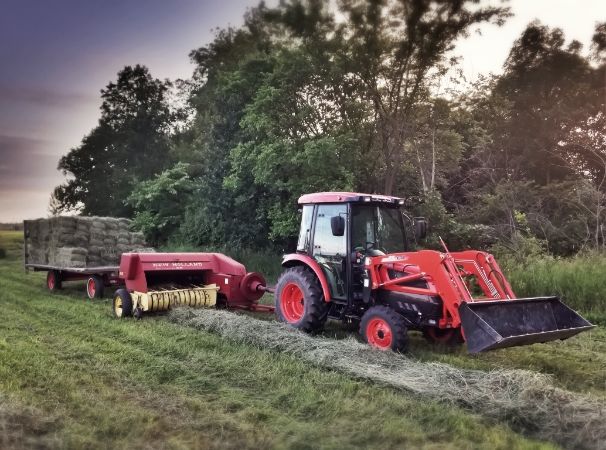Cloudy and overcast today, and it's not raining but spits a bit now and then. I have about 200 bales worth on the ground that was cut Thursday and Friday. It's not dry enough yet. I made a few bales this morning, and ended up cutting them open and spreading them out again. If it was a sunny today it would have been enough. Hope I don't lose it all, some of it is really nice hay.
I took this last night:
Couple of questions and comments. What did you cut it with? You left half the plant in the field. I bet it was a sickle barmower or mower conditioner and you cut with the wind. Always cut against the way the wind blows the plant unless it's a disc machine and keep the cutter bar is an agressive position nose down, Adjust the cut height with the skid shoes always. I can see it's too wet to bale.........if I was in a have to bail that situation, I'd be applying greensaver to the material as it travels into the bailer. I keep an applicator on my bailers (round and square) all the time just in case. Proprionic acid (buffered) allows you to bale at 20%RM so long as the bailer can stand the strain.
Another old girl (bailer that has been around the field a time or two. Appears to be a Hayliner 66 which in it's day was a good machine (I had one starting out and sold it to a hobby farmer and found out later that the original owners manual and shop manual which I had, was worth more than the bailer itself. The issue with an old bailer is everything is chain drive and chains stretch with use and ocassional maintenance. Everything gets sloppy and your bales get sloppy too. New balers are all gear drive. Knotters remian the same except hardened bill hooks are SOP now. Even my new 575 uses the same gearbox your old girl uses. If it's good, keep it.
I never have any attachment on the loader arms in the field. It's cumbersome. Both my large frame Kubota's have loaders that are a PITA to remove but the 2 pin hitch is always empty of an attachment.
I don't care if you do a couple acres or a couple hundred, the one investment anyone making hay needs to make right off, is a moisture tester, handheld or shoe, in bail chamber mounted. While I can look at that forage and tell that bailed, it's gonna get hot and in a month look like it has a bad case of dandruff, but I've been ready to run forage that looks fine and feels fine but my Delmhorst tells me the RM is too high to ble without spoilage.
My Delmhorst wasn't a cheap date (typically 325 bucks for the handheld unit, 2 probes and a case) but they are a lifesaver and I use it at hay auctions to 'discredit' unscruplous sellers. Amazing what happens when the moisture threshold is set at 18% RM and the alarm goes off....
The one I have plugs in via a coaxial cable to sensor shoes in my bailers do I can monitor in real time, the RM of the hay being bailed and if it exceeds a pre set level, I can activate the Greensaver.
You always want to bale small squares below 15%RM but above 10% because at 10% or below the plant shatters from the plunger action and you loose the nutritive value of the forage but above 15%, the compaction of the plunger squeezes the juice out, the bale becomes damp inside, heats up and molds, or worse, sets your barn on fire.
Same occurs with rounds but below 10%, leaf shatter becomes critical and it's hard to start a bale forming, especially in long stemmed forage like Orchard grass.
I can pretty much tell by sight (looking at the baler working) if the forage is right for baling. If it's right, there will be a bit of dust occuring from the plunger action. Not much. Same with rounds. If the round baler is running in a dust cloud, you are shattering the plant and bailing stems. No one wants stens.
